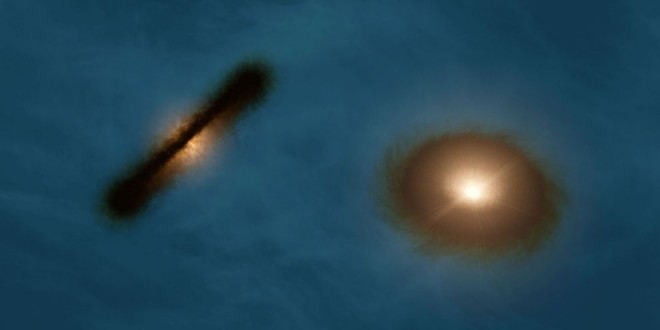Unlike our own lone Sun, most solar systems contain a pair of binary stars; scientists recently observed a pair of “wildly-misaligned” planet-forming disks in a young binary system called HK Tau.
The findings, published today in the journal Nature, were made using the Large Millimeter/submillimeter Array (ALMA), the National Radio Astronomy Observatory reported. The results reveal the clearest-ever picture of protoplanetary disks around double stars; potentially revealing information about the birth and orbit of planets in a multi-star system.
Eric Jensen, an astronomer at Swarthmore College in Pennsylvania, said that ALMA has given them an unprecedented view of a main star and its binary companion sporting mutually misaligned protoplanetary disks and it might be possible to see the formation of a solar system that might never settle down.
He further added that their results demonstrated that the necessary conditions exist to modify planetary orbits and that these conditions were present at the time of planet formation, apparently due to the binary formation process.
The two stars in this system, which are located approximately 450 light-years from Earth in the constellation Taurus, are less than 5 million years old and separated by about 58 billion kilometers, or 13 times the distance of Neptune from the Sun. This system’s companion star, dubbed HK Tau B, appeared fainter to astronomers on Earth because its disk of dust and gas blocks out much of the starlight. The disk itself, however, could be easily observed by the starlight that it scatters at optical and near-infrared wavelengths.
With its unprecedented resolution and sensitivity, ALMA was able to fully resolve the rotation of HK Tau A’s disk for the first time. This clearer picture enabled the astronomers to calculate that the disks were misaligned, meaning they were out of sync with the orbit of their host stars by as much as 60 degrees or more.
The researchers wanted to determine if this type of system was typical or not and they noted that this was a remarkable individual case, but additional surveys would be needed to determine if this sort of arrangement was common throughout our Galaxy.
Agencies/Canadajournal
 Canada Journal – News of the World Articles and videos to bring you the biggest Canadian news stories from across the country every day
Canada Journal – News of the World Articles and videos to bring you the biggest Canadian news stories from across the country every day



